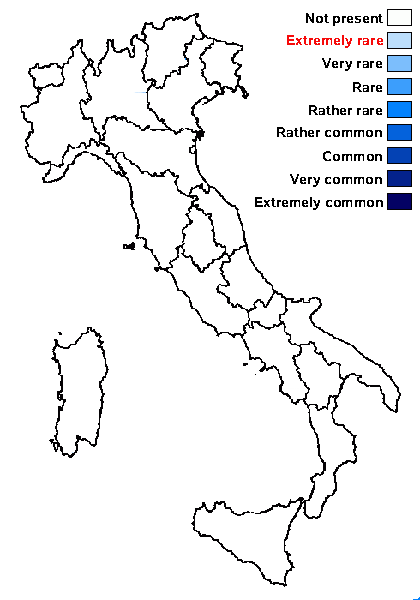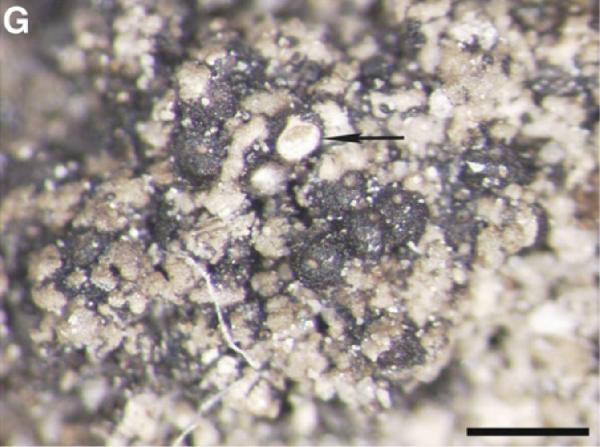Involucropyrenium pusillum Breuss & Türk
Beitr. Naturk. Oberösterreichs, 13: 214, 2004
Synonyms:
Distribution: C - Tosc (Fanfarillo & al. 2024).
Description: Thallus small-squamulose greenish brown, matt, the squamules adpressed to raised at margins, contiguous to slightly overlapping, weakly crenulate-lobulate, 0.2-0.5 mm wide, 100-150 µm thick, paraplectenchymatous throughout, the cells 5-8 µm wide. Upper cortex up to 20 µm thick, poorly developed, consisting of 1-3 layers of cells free of algae; medulla and lower cortex not differentiated; rhizohyphae colourless, 2.5-3 µm thick. Perithecia black (somehow paler around the ostiole), originating among the squamules, subglobose, 0.25-0.4 mm across. Exciple colourless to pale brown, c. 25 µm thick, of tangentially arranged, elongated cells; involucrellum black, completely surrounding the perithecium 25-35 µm thick (thicker in upper part); hamathecium of periphyses measuring 20-30 x 1-1.5 µm, interascal filaments absent; hymenial gel hemiamyloid. Asci 8-spored, clavate, with biseriately arranged spores, the wall I-. Ascospores 1-celled, hyaline, ellipsoid, (19-)20-24(-25) x (8-)9-11(-12) µm. Pycnidia unknown. Photobiont chlorococcoid. Spot tests: cortex and medulla K-, C-, KC-, P-, UV-. Chemistry: without lichen substances. Note: on bryophytes overgrowing boulders of limestone; known from the type locality in the Eastern Alps, and from Portugal; the identification of the sample from Tuscany is not completely certain (Fanfarillo & al. 2024).
Growth form: Crustose
Substrata: rocks, soil, terricolous mosses, and plant debris
Photobiont: green algae other than Trentepohlia
Reproductive strategy: mainly sexual
Commonnes-rarity: (info)
Alpine belt: absent
Subalpine belt: absent
Oromediterranean belt: absent
Montane belt: absent
Submediterranean belt: absent
Padanian area: absent
Humid submediterranean belt: extremely rare
Humid mediterranean belt: absent
Dry mediterranean belt: absent

Predictive model
Growth form: Crustose
Substrata: rocks, soil, terricolous mosses, and plant debris
Photobiont: green algae other than Trentepohlia
Reproductive strategy: mainly sexual
Commonnes-rarity: (info)
Alpine belt: absent
Subalpine belt: absent
Oromediterranean belt: absent
Montane belt: absent
Submediterranean belt: absent
Padanian area: absent
Humid submediterranean belt: extremely rare
Humid mediterranean belt: absent
Dry mediterranean belt: absent

Predictive model
 INDEX FUNGORUM
INDEX FUNGORUM
 GBIF
GBIF


